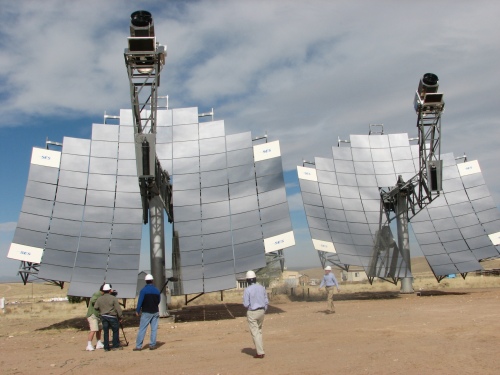
photo: Todd Woody
Fifty-four billion dollars is nothing to sneeze at, of course. That’s the amount in the $825 billion economic stimulus package – introduced by House Democrats Thursday – set aside for renewable energy, electric car batteries, energy efficiency and other green projects.
It’s a start, but that’s less than 7% of the entire stimulus package (or, about enough to pay for the Iraq war for five months, or somewhat more than what the federal government is spending to bail out Bank of America). The lion’s share of the cash is devoted to smart grid technology and transmission lines, with a second big chunk going toward energy efficiency retrofits of public housing and weatherization of low-income homes.
That’s good news for a host of startups developing smart grid technology. But the the bill does not address the most pressing issue facing renewable energy companies today: the credit crunch has dried up financing just as billions are needed to fund factories and the construction of solar power plants and wind farms that will be connected to smart grids and new transmission lines. In recent weeks, layoffs have hit the solar industry. OptiSolar – a Bay Area thin-film solar startup that’s building a 550-megawatt photovoltaic power plant to supply electricity to utility PG&E (PCG) – reported to have furloughed half its workforce. And according to The Oregonian newspaper, SpectraWatt, a solar cell maker spun off from chip giant Intel (INTC) last year, has shelved plans for a factory in Hillsboro, Ore. Friday morning, Kate Galbraith at The New York Times’ Green Inc. blog reported that layoffs have now hit the wind industry.
The retrenchment comes as utilities are counting on solar power plants and wind farms to come online in the next two years to help them meet mandates to obtain a growing percentage of the electricity they sell from renewable sources. In California, for instance, PG&E, Southern California Edison (EIX) and San Diego Gas & Electric (SRE) have signed more than four gigawatts’ worth of contracts for electricity to be produced by large-scale solar power stations that will cost billions to build.
Solar startups rely on a provision that allows them to take a 30% tax credit on the cost of building a power plant. Now most of these companies are startups and have no way to use those tax credits as they’re not profitable. Instead, a solar company must essentially trade the tax credits to a firm that can use them in exchange for cash to finance construction. But investors in these deals have all but disappeared as the financial crisis takes its toll. Which is why solar and wind lobbyists are pushing Congress to make the tax credits “refundable” – meaning those companies that don’t have tax liabilities can trade the credits for cash that can be used to finance power plants. “Due to the recession, projects are now being put on hold, factories are closing and workers face potential layoffs unless Congress refines the tax credits now so they work as originally intended,” said Solar Energy Industries Association CEO Rhone Resch in a statement.
The stimulus package unveiled Thursday undoubtedly will be subject to change, but as written it will boost efforts to modernize and digitize the United States’ aging analog power grid. The bill includes:
- $11 billion for smart grid research and development, pilot projects and the construction of new transmission lines to connect green energy power plants to the power grid. The government will fund 50% of the cost of utilities’ smart grid investments.
- $8 billion in loan guarantees for renewable energy transmission projects.
- $6.9 billion in grants to state and local governments for energy efficiency and carbon reduction programs.
- $6.7 billion for renovation of federal buildings, of which $6 billion must be used for energy efficiency retrofits.
- $6.2 billion for home weatherization programs for low-income families.
- $2.5 billion for energy efficiency retrofits of public housing.
- $2.4 billion for carbon sequestration – so-called clean coal – demonstration projects.
- $2 billion for energy efficiency and renewable energy research (which includes $800 million for biomass and $400 million for geothermal research).
- $2 billion in loan guarantees and grants for advanced vehicle battery research.
The smart grid billions will be a boon to companies like Silver Spring Networks, Gridpoint and eMeter that develop software to allow utilities to monitor and manage electricity use in real-time and provide that data to their customers. “We think 2009 is going to be a good year for us,” eMeter president Larsh M. Johnson told Green Wombat last month. “We’ve seen continued demand from utilities for our services.”
But the billions for the smart grid can be considered a down payment: According to an estimate by research firm New Energy Finance, the price tag for modernizing the power grid over the next 15 years will be $450 billion.